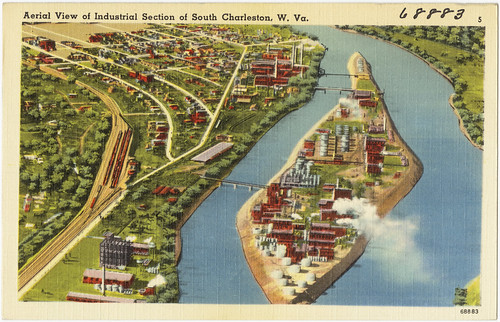I spent the last several articles talking about West Virginia so I figured it wouldn’t hurt to add one more. The introductory post mentioned the oddly named West Virginia Northern Community College. Could I find places in West Virginia that represented each of the four cardinal directions? I guess I could have picked a different directional state for this exercise — North and South Dakota, North and South Carolina — although West Virginia seemed to be my latest fixation. Let’s stick with it.
North Mountain
A few people lived in North Mountain, West Virginia, the first directional community. It didn’t rank much more than a speed bump or a crossroads although it certainly existed. The name came from nearby North Mountain, an actual mountain that stretched about 25 miles from the Potomac River down to and just across the Virginia border.
I couldn’t determine how the mountain got its name although it crossed the length of the northern part of West Virginia’s eastern panhandle. Maybe that offered a clue. North Mountain (the town) nestled near the north span of North Mountain (the mountain) in close proximity to Skinners Gap. That was a lot of North.
The natural beauty of the area inspired visitors and artists alike. A couple of artists created the North Mountain Residency, “open to those who work in visual mediums, installation, performance, text, research forms, and sound, who seek dedicated time and space to develop their practice in a rural, arts-driven environment.” The residency occupied a former apple orchard on a 400-acre property.
North Mountain shouldn’t be confused with Great North Mountain, also along the border between West Virginia and Virginia, although farther south (map).
South Charleston

A sizable city represented another cardinal direction at South Charleston. One would expect South Charleston to sit in close proximity to Charleston, and that would be correct. However, South Charleston wasn’t south of Charleston, it was actually west. South referred to the south bank of the Kanawha River. It reminded me of the conundrum of New Orleans, Louisiana where the West Bank actually occupied a spot east of New Orleans.
I knew Charleston dated its founding to the late 18th Century so I figured something similar applied to South Charleston. Actually, as the city explained,
“The area was still farm land when, in 1907, the Kanawha Land Company was organized and secured title to 1,800 acres. In the year 1907 the street car-line from Charleston was extended to south Charleston and in September of that year a spectacular auction sale was conducted by Plus Levi, selling many of the lots in the newly laid out town”
Industry soon moved to South Charleston including a large Carbide plant (now part of Union Carbide Corporation) onto prime real estate at Blaine Island. Culturally, the city also had a 2,000-year-old Adena Indian artifact known as Criel Mound (map), claimed to be the second largest in the state. I knew the largest one! I just went there — it was in Moundsville.
East Bank

Nearby, maybe 25 miles (40 kilometres) farther upriver on the Kanawha stood the next directional town, East Bank (map). Once again the name came from its position along a watercourse, a rare place flat enough to plat a town in a state known for its mountains. It held about a thousand residents. Nothing much remarkable happened there since its inception in 1899.
The local high school did record one significant alumnus, legendary basketball player Jerry West.
“A smallish youth, West didn’t make his junior high football, baseball or track teams. His only outlet was a basketball hoop nailed to a storage shed outside a neighbor’s house… As a 6-foot senior, West became the first prep player in state history to score 900 points in a season, averaging 32.2 points. With West’s hot hand leading the way, East Bank won the 1956 state title.”
Thus, Jerry WEST began his sports career in EAST Bank, WEST Virginia.
West Union

The town of West Union (map) originally went by Lewisport, according to the Doddridge County government website, a name used since 1850 when it incorporated and became the county seat. However, it didn’t offer an explanation. Wikipedia mentioned the possibility of “a proposed town of Union to be built on the eastern side of Middle Island Creek” that apparently never happened. Thus, West Union existed without a corresponding Union, unlike the situation in neighboring Ohio. Double bonus: it sits along the Northwest Turnpike (U.S. Route 50).
Indeed, I was able to find a settlement in West Virginia that included each of the four cardinal directions.

Leave a Reply